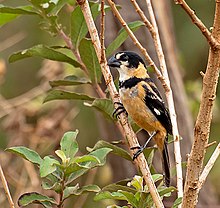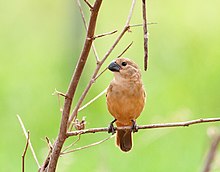| Rusty-collared seedeater | |
|---|---|

| |
| Male in São Paulo, Brazil | |

| |
| Female in São Paulo, Brazil | |
| Conservation status | |
 Least Concern (IUCN 3.1) | |
| Scientific classification | |
| Domain: | Eukaryota |
| Kingdom: | Animalia |
| Phylum: | Chordata |
| Class: | Aves |
| Order: | Passeriformes |
| Family: | Thraupidae |
| Genus: | Sporophila |
| Species: | S. collaris |
| Binomial name | |
| Sporophila collaris (Boddaert, 1783) | |

| |
The rusty-collared seedeater (Sporophila collaris) is a species of bird in the family Thraupidae, formerly placed in the related Emberizidae.
It is found in Argentina, Bolivia, Brazil, Paraguay, and Uruguay. Its natural habitats are subtropical or tropical seasonally wet or flooded lowland grassland, swamps, and heavily degraded former forest.
The rusty-collared seedeater was included by the French polymath Georges-Louis Leclerc, Comte de Buffon in 1775 in his Histoire Naturelle des Oiseaux. The bird was also illustrated in a hand-coloured plate engraved by François-Nicolas Martinet in the Planches Enluminées D'Histoire Naturelle which was produced under the supervision of Edme-Louis Daubenton to accompany Buffon's text. Neither the plate caption nor Buffon's description included a scientific name but in 1783 the Dutch naturalist Pieter Boddaert coined the binomial name Loxia collaris in his catalogue of the Planches Enluminées. Buffon mistaken believed that his specimen had come from Angola. In 1904 the Austrian ornithologist Carl Eduard Hellmayr designated the type location as Rio de Janeiro in Brazil. The rusty-collared seedeater is now placed in the genus Sporophila that was introduced by the German ornithologist Jean Cabanis in 1844. The genus name combines the Ancient Greek sporos meaning "seed" and philos meaning "-loving". The specific collaris is Latin for "of the neck".
Three subspecies are recognised:
- S. c. ochrascen Hellmayr, 1904 – Bolivia to south-central Brazil
- S. c. collaris (Boddaert, 1783) – east Brazil
- S. c. melanocephala (Vieillot, 1817) – southwest Brazil, Paraguay and north Argentina, also southeast Brazil and Uruguay
References
- BirdLife International (2016). "Sporophila collaris". IUCN Red List of Threatened Species. 2016: e.T22723428A94816795. doi:10.2305/IUCN.UK.2016-3.RLTS.T22723428A94816795.en. Retrieved 12 November 2021.
- Buffon, Georges-Louis Leclerc de (1775). "Le grivelin à cravate". Histoire Naturelle des Oiseaux (in French). Vol. 6. Paris: De L'Imprimerie Royale. p. 207.
- Buffon, Georges-Louis Leclerc de; Martinet, François-Nicolas; Daubenton, Edme-Louis; Daubenton, Louis-Jean-Marie (1765–1783). "Gros-Bec d'Angola". Planches Enluminées D'Histoire Naturelle. Vol. 7. Paris: De L'Imprimerie Royale. Plate 659 Fig. 2.
- Boddaert, Pieter (1783). Table des planches enluminéez d'histoire naturelle de M. D'Aubenton : avec les denominations de M.M. de Buffon, Brisson, Edwards, Linnaeus et Latham, precedé d'une notice des principaux ouvrages zoologiques enluminés (in French). Utrecht. p. 40, Number 659 Fig. 2.
- Hellmayr, Carl Eduard (1904). "Über neue und wenig bekannte Fringilliden Brasiliens, nebst Bemerkungen über notwendige Änderungen in der Nomenklatur einiger Arten". Verhandlungen der Kaiserlich-Königlichen Zoologisch-Botanischen Gesellschaft in Wien (in German). 54: 516–537 .
- Paynter, Raymond A. Jr, ed. (1970). Check-list of Birds of the World. Vol. 13. Cambridge, Massachusetts: Museum of Comparative Zoology. p. 139.
- Cabanis, Jean (1844). "Avium conspectus quae in Republica Peruana reperiuntur et pleraeqiio observatae vel collectae sunt in itinere a Dr. J.J. de Tschudi". Archiv für Naturgeschichte (in Latin). 10: 262–317 .
- ^ Gill, Frank; Donsker, David, eds. (2019). "New World warblers, mitrospingid tanagers". IOC World Bird List Version 9.2. International Ornithologists' Union. Retrieved 4 October 2019.
- Jobling, James A. (2010). The Helm Dictionary of Scientific Bird Names. London: Christopher Helm. pp. 113, 363. ISBN 978-1-4081-2501-4.
This article about a tanager is a stub. You can help Misplaced Pages by expanding it. |